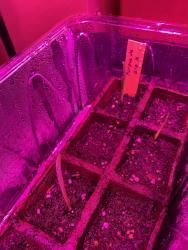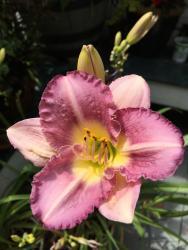SueVT said:a Parentage embargo also seems like a good idea, but what would motivate the hybridizer to reveal this?
In my field, this is automated. You just set your preference at the beginning of the process, and the computer remembers when to make the big reveal. I guess you could moderate the computer's reveal if you wanted an extra layer of security. Seems like there would be a statistical way to calculate the perfect moment (enough time to have a serious head start on genetics, but sharing fast enough to support more serious collection), but my guess is that each hybridizer will have their own preference.
SueVT said:Since Blame it on the Rain came from a $44 5-seed win on the LA in 2015, clearly it is possible for individuals to obtain highest-quality crosses - and they can get lucky, even with 5 seeds. Meghan I will leave it to you to explain the statistical differential between the 15000-seedlings/year hybridizer and this one person with 5 seeds.
WOW, Blame it on the Rain is one crazy-looking daylily! I like it!!
OK, Sue, you asked for it! I almost commented on another thread a few months ago related to exactly this question, and held back because I figured everyone's eyes would just glaze over.
• For those of you who want a short, non-math answer: it depends.
• Sue, Part 2, section 2 is your explicit answer.
• For those who dislike math, stop reading now.
Disclaimer: I do applied population-based inferential statistics, not formal biostatistics or maths. I defer to the true statisticians in the Society for something much much more accurate, nuanced, and elegant.
Assumptions: Let's ignore the obvious challenges of having the required genetics in your founder stock and having a soil condition (pH, composition, micronutrients, etc.) and climate (weather, sun/shade at the right times of day) that will support the trait you want, since the same daylily can look quite different in different gardens.
Part 1 - the genetics
Now, let's say you're trying for a dominant trait with a simple diploid inheritance structure (Z is dominant, z is recessive), and you have one daylily with the Z trait.
If that daylily is heterozygous, you'll have Zz x zz, and with simple combinations, the permutations would be:
Zz
Zz
zz
zz
Therefore, 50% should have the trait Z.
Let's say instead you want a trait that is recessive (z not Z), and again one of your parent plants has it (MUST be zz for a recessive gene to be expressed). If the other parent is heterozygous (Zz), then you, again, have a 50% chance to get zz. But if the other plant is homozygous for a dominant trait (ZZ), then you have a 0% chance because the ZZ plant will always be donating a Z. However, you can then take your Zz offspring (because they all will be Zz in a ZZ x zz cross), and cross them to each other. With Zz x Zz, you'll get ZZ, Zz, Zz, and zz (one in four, or 25%, will have the trait).
Don't ask me about tet inheritance. My mind was blown when I first got excited about daylilies a couple of years ago and learned about the triploids and tetraploids. And then I learned about co-expression...wow...I've read all the cool daylily genetics articles, and have come to the conclusion that I just need to spend a couple of decades hybridizing and I probably still won't get it even then.
Part 2 - the statistics
I think there are two important pieces to understand from a statistics perspective:
1. Combinations: With so many genes, you have a much more complicated picture than the simple example I gave above. This means that you essentially would have to know how many genes were part of the trait you wanted, and then perform a factorial calculation to figure out how many options you would have given different potential combinations. Let's take a simple example of four options. The factorial (4!) would be 4! = 4 x 3 x 2 x 1 = 24. Therefore, we would have 24 different combinations from just those four initial options. (For more of this kind of math, try:
https://www.mathsisfun.com/com...). We'll ignore the possibility that some of these different combinations could actually give you a similar or the same trait. We'll also ignore our lack of knowledge of what genes control what traits and we'll ignore that we don't have millions of dollars to genetically sequence all our hybrids.
2. Population perspective: Sue, this is really your answer. All seeds come from a distribution of possible combinations, and so if you are a hybridizer, and you're looking for a rare trait, you will need 1000s of seedlings (or more) to identify one with a rare trait. That rare trait may, by chance, show up in one of your first seedlings, or it may show up much later. You may even get a small cluster of seedlings with your desired trait, random chance does not mean that all options are perfectly spaced! (Perfect spacing is statistically unlikely, actually.) Whoever was selling the seeds was doing the hard work of creating the population, and it was likely just chance that one particular buyer got a seed that had the rare trait. (Someone eventually wins the lottery, right?)
Part 3 - the wildcard: epigenetics
Hybridization is fun because daylilies have genes that, when expressed, reveal certain traits. However, sometimes genes, even when present, may not be expressed. The gene may be inactivated in different ways (calico cats are a good example of mixed inheritance on a color trait where gene inactivation is important to the cat's coat color, see:
http://www.bio.miami.edu/dana/...).
Some of my colleagues study what causes genes to be inactivated in people, and they've learned that our exposures (for example, to certain chemicals) in the environment can be important. What's even more extraordinary, some of these changes to the expression of the gene can be inherited! So you might see the effects of the environmental exposure in the offspring and not the parent. It isn't the genome that has changed, it's the epigenome (things that block or allow a gene to be expressed, like DNA methylation). The trait is still there, it's just blocked.
I have NO idea how much this applies to daylily traits, but it's a really cool concept and could partially explain why some people have real luck with certain traits and others don't.
I hope this has been useful to someone!
Meghan


